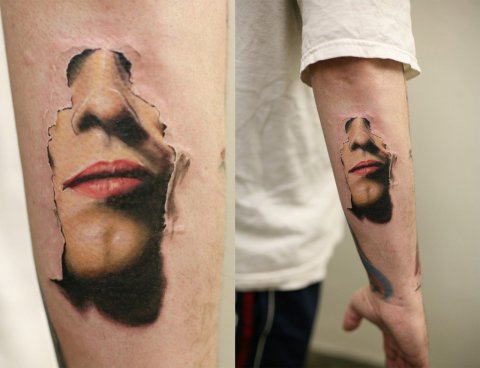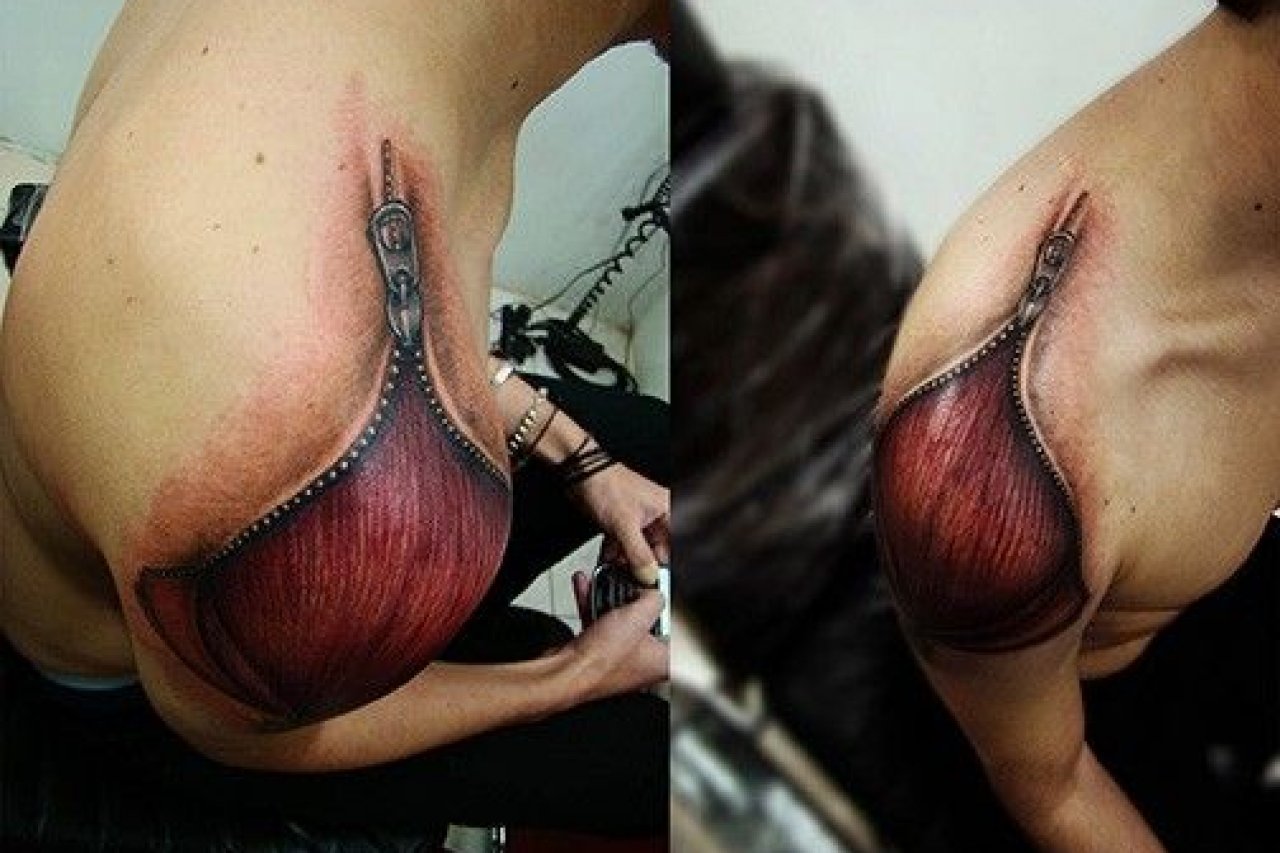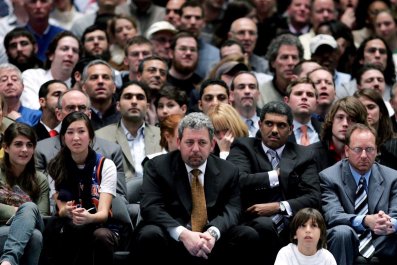A zipper runs over the curve of a man's bare shoulder. It is unzipped over his deltoid, almost to his neck. Skin appears to bunch around the seam. Where the zipper parts, the ruddy red grain of muscle is exposed. At first glance, it looks like a grizzly replacement for stitches, like a macabre surgical joke. Look a little longer, and the sketch lines become clear. It's a very convincing tattoo.
Yomico Moreno, the Venezuelan tattoo artist responsible for that unzipped shoulder, is one of the rising stars of a relatively new genre in tattooing. Dubbed "3-D tattoos," they emphasize contrast and shadow to create the illusion of dimension. Moreno's portfolio boasts images of hyperrealistic objects like cockroaches and pocket watches that appear to sit atop the wearer's skin. In others, chasms open in the wearer's flesh, exposing muscles or cyborg-like mechanical parts, according to one's taste.
Moreno's favorite of his tattoos is a thick yellow snake, coiled like ribbon candy on a man's forearm. The snake's musculature is defined below its scales and the tip of its tail is lifted subtly, producing a tiny pointed shadow.
"This one was a big challenge because I had to anatomically study many pictures of snakes to get that texture, to give the impression of something quite real," Moreno tells Newsweek.
The 3-D style has caught on so rapidly in Caracas, where Moreno works, that his waitlist is often eight months long. Artists estimate the style began to emerge 10 years ago, but the demand for 3-D tattoos has spiked over the last year, as has demand for images of the shocking body art online.
Rocky Rakovic, the editor of Inked magazine, says a gallery of 3-D tattoos has been one of the most heavily trafficked features on the magazine's website for the past few months. The images make for perfect viral content: They deliver a satisfying shock first from their fleeting ability to trick the eye into believing a spider is actually crawling toward that woman's hairline or a set of teeth are really protruding from that man's neck, and second, by the realization that someone with a needle gun achieved that illusion.
"I think 3-D tattoos are so new to us that they are still jarring," Rakovic says. "Our brains are accustomed to process the idea of art on skin, but not yet for art jumping off skin."
The 3-D tattoo was born out of an "umbrella" tattoo genre called realism. Rakovic describes it as exactly like the 19th century fine art movement of the same name: an attempt to depict people and things as accurately as possible. Realist masters in tattoo, like Nikko Hurtado, Stefano Alcantara, and Paul Acker, create stunningly detailed portraits that verge on the photographic.
"When it's done, and that customer gets up and looks in the mirror and starts crying because it so real, it doesn't get better than that," says Terry Hoffman, a realist tattoo artist based in Arizona.
Realism is a demanding genre, and often requires a level of artistic expertise unheard of in the tattoo world a few decades ago, when tattooing was largely a marginalized endeavor and few people in the trade dared call themselves "tattoo artists." In the U.S., tattooing was pushed further to the fringes of popular culture by laws: By 1962, tattooing was illegal or restricted in 32 states and, by 1968, 47 U.S. cities had banned it. In New York, for example, tattooing was banned in 1961 after a hepatitis scare, and didn't become legal again until 1997.
Now, tattoos are a booming industry. In 2012, 36 percent of people between 18 and 25 reported having at least one tattoo, as did 38 percent of people between 30 and 39.
The days of traditional sailor tattoos and pinup girls are certainly not over. But tattooing has undergone dramatic artistic advancement in recent years, in part due to better pigments and needle guns. "But it's also really the younger generations that are coming up. Twenty-five years ago there weren't kids coming out of art school who were going into tattooing. It was the pick-a-design-off-the-wall era," Paul Booth, a tattoo artist at the Last Rites studio in New York, tells Newsweek. He got his start the traditional way: by apprenticing for another artist and then taking "guest spots" at various tattoo studios. "When you look back, it's like, Was that the best we had? I look back on my work and it is sometimes embarrassing," he says, laughing.
Booth has been tattooing for 25 years and is considered a master of realist and biomechanical tattoos, a related subgenre influenced by Swiss surrealist artist H.R. Giger. Biomechanical tattoos often combine metal rods, motors and gears with musculature to visually alter human anatomy. Using light and shade, Booth can visually lower a client's ribcage, or make it appear concave. "It sounds rather macabre, and it is. It's the optical illusion I enjoy," Booth says. In a testament to tattoo's increasing overlap with fine art, Booth was invited to join the National Arts Club in 2005. The waitlist to get one of his tattoos is two years long.

While many tattoo artists, like Moreno, are still self-taught, more and more are coming out of art school and bringing a sophisticated body of knowledge with them. "Since the 1980s, there's been more MFA graduates than at any other time in history, and certainly the MFA graduates can't all be absorbed into the art system. So they've learned all the techniques of artmaking and modernist theories behind how to make art - that it should progress, and push in a new direction. All that has migrated into the tattoo work," explains Mary Kosut, an associate professor of Media, Society and the Arts at SUNY's Purchase College, who has written on what she calls the "artification" of tattooing. "It's really common to hear artspeak in tattoo shops and see art books in tattoo studios. In fact, we used to say 'shop' and now we say 'studio.' "
For Kosut, the 3-D tattoo is a logical next step in the evolution of tattoos-as-art. "They confirm the notion that the skin is a canvas," she says.
When Cassie Stover graduated with a fine arts degree from the University of Oklahoma in 2005, she never thought she would end up with a tattoo gun in her hand instead of a paintbrush. But a year after graduation, when tattooing became legal in Oklahoma, she submitted her portfolio to the state and qualified for a tattoo license.
"They are essentially tiny paintings," Stover, who opened her own studio in Oklahoma 2008, says. "So with my painting background it made more sense for me to do 3-D. My art doesn't have a heavy black outline or that flat cartoon-like aspect of traditional tattoos."
One of Stover's most intriguing tattoos is a meticulous reproduction of a painting by artist Joshua Suda, of a woman's face bursting through paper. Except in Stover's tattoo, the face bursts through the skin on the wearer's forearm.
Many people who come to Booth for hyperrealistic tattoos hope to face some past trauma, "or their demons, I call it, because I grew up Catholic," Booth says, laughing. He once tattooed a young woman who was treated with shock therapy in her youth. She'd lost a year and a half of her memory and couldn't remember her first husband. She came for a full-arm tattoo, called a "sleeve." Booth wrapped her arm in portraits of her own face, contorted in agony as shock therapy is administered in the form of symbolic lightning bolts. "Things like this serve people as an outlet or a venting process, as opposed to being stuck with their trauma, which sounds counterintuitive to most people. Whenever she looks at her arm she can look back at it as a historic time in her life, a time that's over," Booth says. For them, the tattoos are a healing experience. "Even though the imagery is extreme and dark, the end result is lightness, a lifting. They've externalized it."
But what about a tattoo of metal rods and gears in one's leg? Or an extremely convincing tarantula meandering up one's back?
"Sometimes people just want a tattoo that'll scare the little old lady in the supermarket. I'm one of those people. I have half my head tattooed, to my face," Booth says, laughing. "Not all tattoos have to be therapeutic."


























